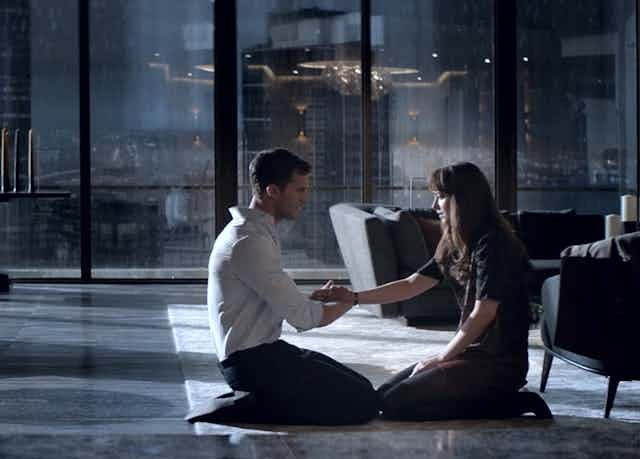At the end of Fifty Shades of Grey, the first in E L James’ trilogy of novels now adapted as films, protagonist Anastasia ends her abusive relationship with the dominating businessman Christian Grey. She had attempted to understand his dark side, by “allowing” him to beat her. Traumatised, Anastasia vowed never to see him again.
The sequel, Fifty Shades Darker, opens in Australia this week. The movie is targeted at women. One of us attended a “girls’ night out” premiere. As they arrived, attendees were given beauty products and vaginal wipes.
Equipped to transform themselves into sexually desirable conquests, the audience was there to witness Anastasia’s tokenistic resistance to Mr Grey’s domination and demands. The film attempts to persuade us that claiming a male fantasy as our own, is, in fact, empowering — and the perfect way to get the guy.
After the first movie, there was debate about its romanticisation of an abusive relationship. The sequel confirms that this wasn’t a misconception. As researchers, we are interested in the representation of women’s sexuality in media and how this influences women’s sexual health. Films such as Fifty Shades Darker, seen by millions of men and women around Australia, have the power to influence our perceptions of women’s sexual agency.
In the sequel, Anastasia agrees to see Mr Grey again because he pledges that “having” Anastasia is more important than fulfilling his controlling sexual fantasies. He promises to communicate and to reveal more of his traumatic past.
Mr Grey asks Anastasia to move into his apartment and to marry him at a time when they are dealing with a sexually harassing boss, she is being stalked and threatened by his former (now traumatised) “sub” (submissive partner), and they have a run-in with Mr Grey’s former abuser — not to mention Mr Grey enduring a freak helicopter crash. Not at a time when life is calm and he is demonstrating what a new man he is.

Is this the dream? A self-identified sadistic, controlling man wants us to believe he’s been transformed by the love of a young woman and her supposed assertion of agency through small expressions of her limits. The proof, we are asked to accept, is in the fairy tale ending: flowers, fireworks, and a diamond ring.
In reality, women stay in abusive relationships because they are physically, financially, or psychologically restricted or threatened. They endure the torment because they want to believe the man (or woman) will change.
The fairy tale ending to this film is presented to women as evidence that the sadistic man who stalks her, controls her and disrespects her requests for independence will change through the power of her love.
In the first film, Mr Grey initiates and directs all sexual interactions with a passive Anastasia who appears to enjoy it all. In Fifty Shades Darker we are encouraged to believe that Anastasia has developed maturity and power when she tells Mr Grey she wants to be “kissed”: her euphemism for oral sex.
Later, she asks to be “spanked”. After she accepts his marriage proposal, Anastasia initiates a return to the “red room”, a room filled with tools for “punishment” and sexual pleasure, the scene of her earlier trauma. The sex at this point looks a whole lot like what Mr Grey enjoys.
When women “choose” the male fantasy they are not creating their own. They are robbing themselves of the chance to explore and to express their needs and desires, to reveal and understand their own preferences and aversions.
Enjoying sex is not just about pleasing the sexual partner; it entails knowing your own body, understanding your emotional experiences, and having the freedom to express your needs.
Women’s acceptance of the male fantasy parallels our emerging research findings. At the Jean Hailes Research Unit in the School of Public Health and Preventive Medicine, Monash University, we are investigating young women’s (aged 18-30) experiences of and reflections on pornography.
Our early analysis (unpublished) indicates that, in women’s eyes, most pornography depicts men initiating and directing sexual activity, women accepting it without attempts to direct or modify it, and women enjoying any sexual practices men initiate. Sound familiar?
Women have told us that viewing and enacting this “script” has led them to suppress their own needs, thus limiting their sexual pleasure. They spoke about mimicking porn actors to please men. Men might not have asked them to do this but women often took for granted that it was expected of them.
Some women felt that saying “no” to a sexual practice or to a request from a male partner was not an available option. If they contemplated refusal, it was expected or found to be extremely uncomfortable.
In a world where the US president, a man accused of serial sexual harassment, has signed away women’s reproductive rights, we need to be concerned about how women can claim agency over their bodies and lives.
When it comes to relationships and sexual pleasure, let’s be real about what empowerment means: education, the right to say no, freedom of expression, the opportunity to explore, and choice.
For these crucial goals, Fifty Shades Darker is not an aspirational story for women. Mr Grey is no Romeo. He is the antithesis of a desirable role model for men.

